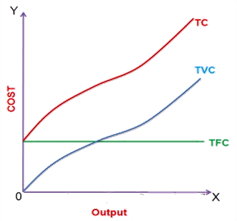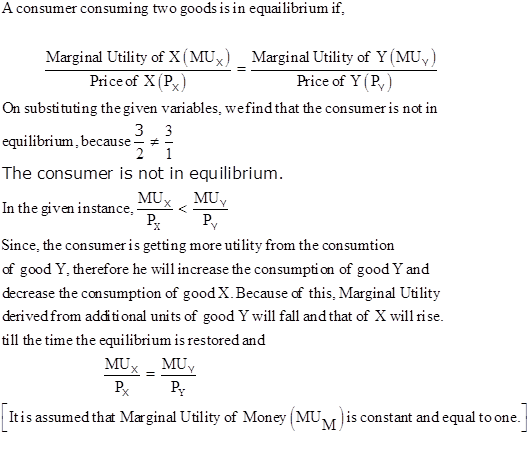Economics : 2016 : CBSE : [All India] : Set III
To Access the full content, Please Purchase
-
Q1
Differentiated products is a characteristic of :
(Choose the correct alternative) :
(a) Monopolistic competition only
(b) Oligopoly only
(c) Both monopolistic competition and oligopoly
(d) Monopoly
Marks:1View AnswerAnswer:
(c) Both monopolistic competition and oligopoly
-
Q2
Demand curve of a firm is perfectly elastic under :
(Choose the correct alternative)
(a) Perfect competition
(b) Monopoly
(c) Monopolistic competition
(d) Oligopoly
Marks:1View AnswerAnswer:
(a) Perfect competition
-
Q3
What happens to the difference between Total Cost and Total Variable Cost as output is increased?
Marks:1View AnswerAnswer:
The difference between total cost and total variable cost remains the same at all level of production.

-
Q4
A firm is able to sell any quantity of a good at a given price. The firm’s marginal revenue will be :
(Choose the correct alternative) :
(a) Greater than Average Revenue
(b) Less than Average Revenue
(c) Equal to Average Revenue
(d) Zero
Marks:1View AnswerAnswer:
(c) equal to Average Revenue
-
Q5
When does ‘shift’ in supply curve take place?
Marks:1View AnswerAnswer:
The shift in supply curve takes place due to change in following determinants:
· Prices of related commodities
· Goals of the firm
· Prices of different factors of production
· Technique of production
· Expectation of future prices
· Government taxation policy
· Natural factors
· Means of transportation
-
Q6
What will be the effect of 10 percent rise in price of a good on its demand if prices elasticity of demand is (a) Zero, (b) -1, (c) -2.
Marks:3View AnswerAnswer:
-
Q7
What is minimum price ceiling? Explain its implications.
Marks:3View AnswerAnswer:
Minimum price ceiling is also referred as ‘price floor’. In the following diagram, the price floor is depicted.
Price floor refers to the minimum price fixed by the government for a commodity in the market to protect the interest of the producers. The government in most countries fixes floor price for most agricultural products especially for food grains.
In the above diagram, the equilibrium price is OP, but the floor price is OP*, which exceeds the market determined equilibrium price. Due to price ceiling (the price above the equilibrium price) there is excess supply in the market. The government invariably steps out in the market and buys this excess supply to be stored in the form of buffer stocks and be used at the time of shortages.
-
Q8
If the prevailing market price is above the equilibrium price, explain its chain of effects.
Marks:3View AnswerAnswer:
With the help of the following schedule we can understand the situation when the market price is above the equilibrium price.
With reference to the above schedule, if the market price is
 5 (which exceeds the equilibrium price of
5 (which exceeds the equilibrium price of  3), then the supply of commodity X is 25 units but the demand is of 5 units only. With a view to increase their sales, the sellers will reduce the price till demand is equal to supply.
3), then the supply of commodity X is 25 units but the demand is of 5 units only. With a view to increase their sales, the sellers will reduce the price till demand is equal to supply.Suppose the market price is
 4 now. At this price, the demand has increased and supply has reduced but still there is excess supply. Demand is of 10 units and supply of 20 units. Excess supply will force the market price to slide down further till the equilibrium between supply and demand i.e. at
4 now. At this price, the demand has increased and supply has reduced but still there is excess supply. Demand is of 10 units and supply of 20 units. Excess supply will force the market price to slide down further till the equilibrium between supply and demand i.e. at  3. Thus, equilibrium price will be restored in the free market economy.
3. Thus, equilibrium price will be restored in the free market economy. -
Q9
A consumer consumes only two goods X and Y. Marginal utilities of X and Y is 3. Prices of X and Y are Rs 2 and Rs 1 respectively. Is consumer in equilibrium? What will be further reaction of the consumer? Give reasons.
Marks:3View AnswerAnswer:

-
Q10
Define fixed cost. Give an example. Explain with reason the behaviour of Average Fixed Cost as output is increased.
Marks:4View AnswerAnswer:
Fixed (FC) is the sum total of expenditure incurred by the producer on the purchase or hiring of fixed factors of production. These are also called supplementary costs or overhead costs or indirect costs. For example, expenditure on paying rent of the factory, insurance premium, salaries of the permanent employees etc.
This cost cannot be avoided and they do not vary with the level of output. Fixed cost is positive zero even at zero level of output.
Average fixed cost (AFC) is defined as the Fixed Cost of producing per unit of the commodity. It is obtained by dividing Total Fixed Cost (TFC) by the level of output.
AFC falls continuously with the rise in the level of output because in the formula only denominator increases and numerator always remain constant. But the AFC never becomes zero, as TFC is constant and always remains positive.



